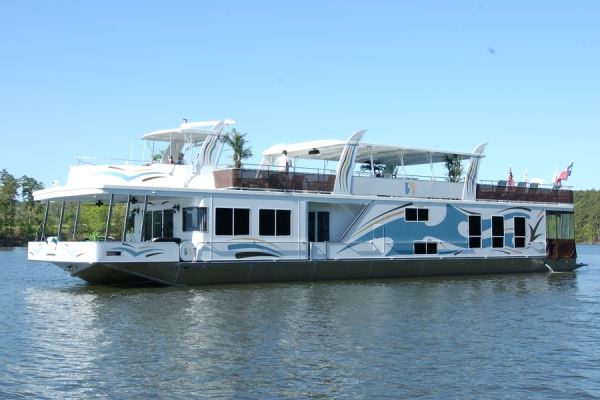 So you and your family decide to plan your next big adventure or weekend activity. Only this time it is not a house on wheels you are going for, but literally a house that can sail the open waters while providing all the necessary comfort of a home and more. Whether you are a boat lover, traveler, or longing for life on the water, the houseboat can become a trustworthy companion that helps you navigate and live a life at the destination.
So you and your family decide to plan your next big adventure or weekend activity. Only this time it is not a house on wheels you are going for, but literally a house that can sail the open waters while providing all the necessary comfort of a home and more. Whether you are a boat lover, traveler, or longing for life on the water, the houseboat can become a trustworthy companion that helps you navigate and live a life at the destination.
Now the first thing that activates in our minds when we see a houseboat is that it is highly difficult to operate. On the contrary, once you learn the ropes it is all smooth sailing. Nonetheless, you need to know the fundamentals before you begin your trip with family and friends, but don’t worry we got you covered. Whether you are looking to buy or rent, here are the basics of how to operate a houseboat as a newly appointed captain.
Ladies and gentlemen start your engines:
Before starting out your crew should receive the mandatory instructions from the marina staff responsible for the houseboat. This will help you get a common understanding of terms definitions and operational procedures in different scenarios. The captain needs to have a driver’s license so tachometers, gears, shifters and different indicators may sound complex, but shouldn’t feel alien. Other elements like lights, fuses and switches work exactly like those in your home. Still, in order to talk, there are key terms every captain and his or her crew need to know. For example, the helm is the most important part of your boat, it is the captain’s seat where all driving and maneuvering takes place.
The front of your houseboat is called the bow and the back is called the stern. The right side of your vessel is called the starboard and the left is called the port side. To manage complexity always refer to the houseboat manual for clarification. Once the basics are covered you can easily continue to the operating part of the houseboat. It is similar to driving a car, with a few differences that come from the “start”. Houseboats can come with one or two engines, but the start procedure is similar for both cases. Here’s what you’ll need to do:
- Turn the blower on for 5 minutes. It brings fresh air to the engine that is used for combustion.
- Double-check that your engine is in the neutral position. The shifter should be positioned straight up.
- Turn the port side engine key one click to the right until you will hear a beeping sound. That means it is “ON”.
- Push the control button, normally located at the bottom of your shifter. As soon as you press it, a flashing light will appear meaning that you are ready to start the boat.
- Turn the key as you would with a normal car all the way to the right. The engine will roar and will start running.
- Leave your houseboat in an idle position for about 5 minutes so your engine becomes nice and warm.
Note: If you have a two engine houseboat you will need to repeat this procedure for the port and starboard engine.
Docking & Anchoring
When you enter the houseboat for the first time it is always docked either at the harbor or marina. There is personnel at the ready to help you move or dock the houseboat, but you should really try and learn the process on your own. Experienced captains thoroughly enjoy this activity, while beginners need to overcome their fears. It is not a race, so start nice and slow. Always use the helm to move the boat from the docks or lakeshores, never the top deck area.
Check your surroundings, make sure your houseboat is positioned correctly, and start your engines. Use the minimum speed of one mile per hour to get your houseboat off the docking area and on to open waters. If you reach an area that piques the family’s interest and where you decided to spend the night, know that there are specifics when docking on a lakeshore.
First, line up the boat (bow facing land) and slowly nudge it toward the coast. Once in position, keep the engines running to compensate if the boat moves back and forth. Have your crew put up the anchors at a 45-degree angle on the shore. Bury them in holes at least 2 feet deep. Once you feel the houseboat is well in place, turn off the engines. Depending on the weather conditions you may want to check up on your anchors from time to time, but normally they keep the houseboat steady. Experience is key, but this should cover your basics on how to execute and feel comfortable with docking maneuvers.
Driving in open waters
Phew, now that docking is out of the way, let’s continue to the most pleasant activity - sailing in open waters. All you need to do is get control of the wheel and explore. It is a good time to get to know your houseboat. Each one is different, but there are some common elements to them. Houseboats average 35 feet in length, have a max speed of about 30 miles an hour and weigh about five tons. You don’t want to hit anything with your titanic vessel. Unlike cars, houseboats have no brakes, so bear that in mind when having a speed rush in open waters.
Emphasize on “no breaks”, there is no pedal. Breaking or coming to a full stop means switching your engine to reverse while compensating for the forward momentum. Driving overall is simple, but has its quirks, these are houses on the water we are talking about. When you turn the wheel, it takes some time before the maneuver takes place. It is the stern that reacts first and if the wheel is turned to the left, the stern goes to the right, opposite of how a car responds. This may seem strange at first so plan ahead before making a turn.
Remember captain, practice makes perfect!
Houseboats International
Houseboats are international vacation phenomena across Europe and the US. When navigating the open waters there are rules and regulations, captains need to be aware of. Various states' countries where houseboat sailing is practiced come with their own regulations. Make sure you have done the research and follow the laws before heading out on the journey. As an example here are some general written and unwritten rules and values that you need to know:
- When approaching an oncoming boat, keep to the right
- Know and use proper maneuvering signals in open waters
- Don’t operate under the influence. This is especially important for those pursuing boat driving or commandeering. According to words of Eugen Kolwitz, a freelance writer at the best resume writing service, reputation and navigational expertise is the mix we are looking for in a captain”
- Use common courtesy when on your journey. Maintain a steady course and keep a safe distance from other vessels
Houseboat Tips
Now that you have a grasp of what it means to operate your houseboat, here are a few extra tips to keep your crew safe and engaged:
- You’ll want to assign a deckhand or second in command. Not only useful but also a great family bonding experience.
- Have a spotter (someone looking out) when doing backward maneuvers
- You can pilot your houseboat in open waters from the top deck. Remember docking maneuvers are done from the helm, mandatory.
- In emergencies: use your boat radio to ask for assistance.
- Four short horns are an international distress signal for boats, use it wisely
- Slips, trips and falls = be aware of your environment, don’t throw gear in key passages, be careful of wet slippery zones and keep them as dry as possible
- Always clear fumes before starting the engine
- Always headcount before the engine starts. It is a captain’s responsibility
- Before going on a journey be aware of the weather conditions
- Make sure your kids are supervised and are wearing vests and keep your parent radar in check
- Prioritize safety and control. Bad weather equals shelter!
Houseboat vacations cater to every personality type. The adventurers can find new places to discover, creatives can find secluded spaces to spark that creativity. Content writers at essay on time find it a great place for brainstorming topic ideas. Even if you need to get caught up on remote work, today there are many tools and software like Best Custom Essay to get the job done right from the comfort of your floating home. Make sure to leave all your worries behind when going on the trip.
Conclusions
With boat sale numbers remaining strong in 2020 houseboats will remain a high-value home on the water experience for friends and families. Whether it is your first journey or navigational mastery is coursing through you and the crew, never forget to stick to the basics. Make sure to have professionals clarify all unanswered questions, take the helm, start off your engine and make your way towards open waters. The houseboat is similar but unlike your everyday car driving experience. Be mindful of its maneuverability when docking or leaving the marine and make sure to double-check any safety features. Remember mastery comes with experience. Be respectful and cooperative with others when navigating open waters to make this house feel like a home. It is what you make of it!
 Author Bio
Author Bio
Tiffany Harper is a training guru who’s been working in the corporate sector for over a decade now. She is a management graduate and loves to share her experience through blogs and articles with Best Dissertation Service. For her love of writing, she also provides freelance college paper, and dissertation writing services while helping Buy Custom Essay and Dissertation Today.